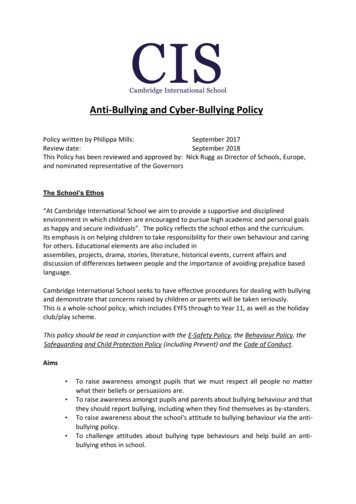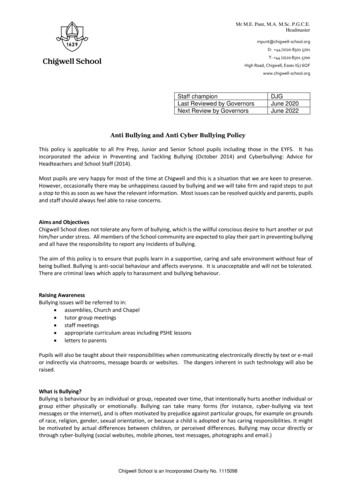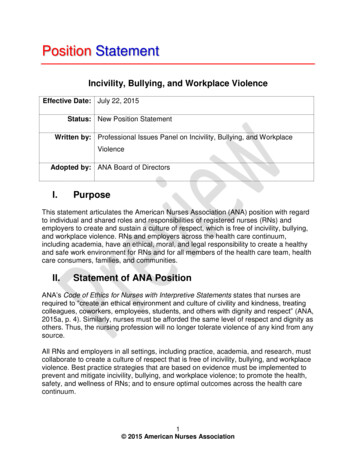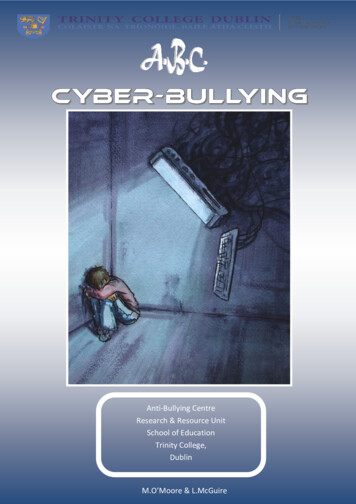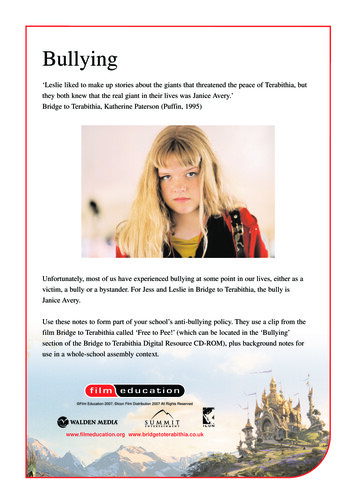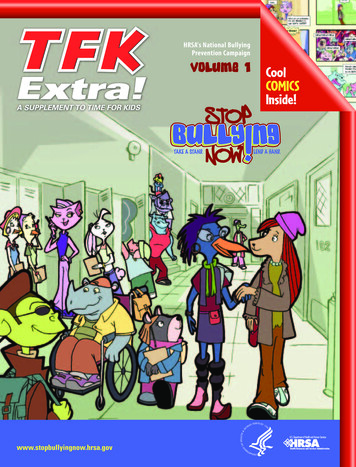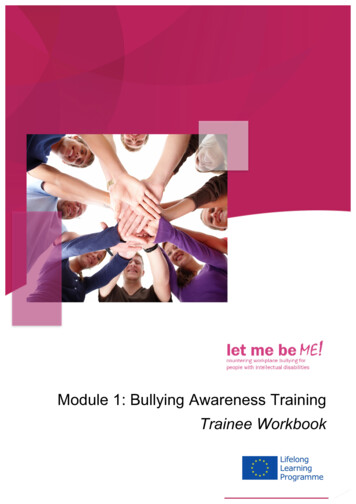
Transcription
Module 1: Bullying Awareness TrainingTrainee Workbook
Trainee Signature:Date:In the first section you will learnn what workplace bullying isn what cyber-bullying isn the signs shown by a possible bullying victim and by a bully.This module is an introduction to the rest of the course modules in which you aregoing to learn how to protect yourself from bullying (module 2) or from becoming abully (module 3) and learn what to do when being bullied (module 4).In your trainee workbook you will find the worksheets of the training course. You willget to say what you thought of each module and keep a summary of them. Thesummaries may help you to remember the course when you look back at them.
Trainee Signature:Worksheet 1Date:Evaluation: Workplace bullyingTick what activities you took part in today:¡ video¡ ¡ case studiesactive gamePlease answer the following questions:EvaluationDid you like this module in general?¡ yes ¡ no ¡ don’t knowDo you now know what workplace bullying is?¡ yes ¡ no ¡ don’t knowDid you like the activities you did?¡ yes ¡ no ¡ don’t knowDid you find this module’s topic interesting?¡ yes ¡ no ¡ don’t knowIs there anything else you would like to have learned in this module? If yes, pleasemention,what:What did you learn today? Please write or draw what you learned about workplacebullying.
Trainee Signature:Worksheet 2Date:Summary: Workplace bullyingCharacteristics of workplace bullying1Workplace bullying is when someone’s behaviour makes you feel bad aboutyourself. The behaviour is on purpose and happens a few times; it’s unfair andnot your fault in any way.Types: verbal, physical, gesture, social, extortion, cyber-bullyingParticipants: bully(s) (colleague, manager, superior, job coach ), bullied person,witnesses, bystandersPlaces where bullying can happen: on the way to and from work, at the workplace,during breaks, via Internet or mobile phoneEffects: impact on well-being, health and work performanceExamples of workplace bullying actionsPicking on someone all the timeShouting at staffInsults and use of nasty nicknamesSomeone making fun of you or making you look sillyConstant criticismBlaming staff for mistakes they haven’t madeSpreading rumours about someone elseEncouraging other staff to ignore another staff member's ordersIgnoring/ excluding an individual’s opinions at meetingsRefusing reasonable requests for leaveBlocking a person’s promotionExclusionUntrue evaluation of job performanceRefusing information important to your workWithdrawal of work1O'Moore, M. (2000). Summary Report on the National Survey on Bullying in the Workplace. AntiBullying Centre, Trinity College Dublin.
Trainee Signature:Date:Worksheet 3 Case studies:Identification of workplace bullyingScenario 1:Mrs A. works in a café. Her supervisor is always telling the employees to be on time,to wear clean and respectable clothes, including a white shirt or blouse and an ironedapron with the logo of the café. The employees keep their clothes in a common roomof the café.Several times recently, Mrs A. had to look for her work clothes in the morning. Shefound the apron crumbled in the bin or behind the lockers which made her late forwork. Her supervisor was annoyed and told her to get up earlier to be on time.One day she couldn’t find her blouse at all and had to go into the café with her redT-shirt on. Her supervisor got very angry and told her to go home.Please tick if the scenario describes workplace bullying: ¡ yes ¡ no
Trainee Signature:Date:Worksheet 4 Case studies:Identification of workplace bullyingScenario 2:Mrs A. has an intellectual disability. She works on a production line. Recently she hashad difficulties keeping up with the pace and has made some mistakes.As usual, every three months all supported employees have a meeting with thesupervisor to check if anything should be changed.This time in the meeting, Mrs A.’s supervisor speaks with her about the mistakes andthe difficulties of recent weeks. The supervisor asks her if the job is too difficult forher at the moment and if she wants to work in another area.Mrs A. is angry and thinks that the supervisor wants to fire her.Please tick if the scenario describes workplace bullying: ¡ yes ¡ no
Trainee Signature:Date:Worksheet 5 Case studies:Identification of workplace bullyingScenario 3Mr B. works in a kitchen. It is normal for the employees to spend the breaks togetherin the common room. Here everybody talks about work and also about private things.Mr B. would like to participate, but the others ignore him. He has tried to startconversations with his colleagues, but his colleagues pretended he said nothing.He usually sits alone at a table during the breaks. Mr B. is afraid of the breaks as hecan’t stand the feeling of being alone and excluded. He likes his work, but hethinks about quitting the job because of the breaks.Please tick if the scenario describes workplace bullying: ¡ yes ¡ no
Trainee Signature:Date:Worksheet 6 Case studies:Identification of workplace bullyingScenario 4:Mr B. works in sheltered employment. He has been ill and has been lying in bed forthe last two weeks.When he comes back to work, his colleagues make a joke: “Hey, Mr B., did you enjoyyour two weeks off? Did you have a nice holiday?”Mr B. is upset and wants to go home again.Please tick if the scenario describes workplace bullying: ¡ yes ¡ no
Trainee Signature:Date:Worksheet 7 Case studies:Identification of workplace bullyingScenario 5:Mr B. is a shy young man working in a big company.For some time he has noticed that his colleagues avoid contact with him. Every timehe enters the room his colleagues are whispering. Some colleagues giggle andpoint at him.Today his manager has asked him if it is true that he has lice.Please tick if the scenario describes workplace bullying: ¡ yes ¡ no
Trainee Signature:Date:Worksheet 8 Differences between bullying andcriticism, jokes or wrongdoingPlease judge, if the following actions describe bullying or not.ActionEvaluationRepeated name-calling¡ bullying ¡ no bullyingCriticism of appearance¡ bullying ¡ no bullyingExclusion from events¡ bullying ¡ no bullyingCriticism of job performance¡ bullying ¡ no bullyingStealing of things¡ bullying ¡ no bullyingBeing forced to do others’ work¡ bullying ¡ no bullyingBeing the butt of everybody’s jokes¡ bullying ¡ no bullyingSarcastic comments¡ bullying ¡ no bullyingCalling people nicknames¡ bullying ¡ no bullyingTargeted physical attacks¡ bullying ¡ no bullyingSpreading of rumours¡ bullying ¡ no bullyingInsensitive remarks¡ bullying ¡ no bullying
Trainee Signature:Date:Worksheet 9 Appropriate evaluation of differencesbetween bullying and criticism, jokes or wrongdoingAppropriateevaluationReason for evaluationbullyingIf it is not a nickname, and you are insultedagain and again, it is bullying. A single insult isnot bullying.Criticism ofappearanceno bullyingIf the criticism is justified and not said as aninsult and if you are getting helpful hints onwhat to change, it is not bullying.Exclusion fromeventsbullyingIf you are continually excluded from events, itis bullying.no bullyingIf it is about mistakes you really made, it is notbullying. If there is no reason for it and itcontinues, it may change to bullying.Stealing of thingsno bullyingThe single stealing of something is notbullying. If it happens again and again andonly to you, it is bullying.Being forced to doothers’ workbullyingBeing the butt ofeverybody’s jokesbullyingIf it is not single event, but intended acts tohurt you, it is bullying.Sarcastic commentsno bullyingSome people don’t think about what they aresaying. Some are using irony which is difficultto understand. A single statement is notbullying.Calling peoplenicknamesno bullyingIf you are called nicknames by a friend or acolleague you know well, it is not bullying. If itis insulting, it may change to bullying.Targeted physicalattacksbullyingIt’s not only bullying, it is also an offence. Youhave the right of physical integrity.bullyingIf someone is talking behind your backintending to damage your reputation, it isbullying.no bullyingSome people don’t think about what they say.If it’s a single inappropriate statement whichhurts you, it’s not bullying.ActionRepeated namecallingCriticism of jobperformanceSpreading ofrumoursInsensitive remarksYou needn’t do what you don’t want to do as itis someone else’s job, so this is bullying.
Trainee Signature:Worksheet 10Date:Evaluation: Cyber-bullyingTick what activities you took part in today:¡ ¡ videocase studiesPlease answer the following questions:EvaluationDid you like this module in general?¡ yes ¡ no ¡ don’t knowDo you now know what cyber-bullying is?¡ yes ¡ no ¡ don’t knowDid you like the activities you did?¡ yes ¡ no ¡ don’t knowDid you find this module’s topic interesting?¡ yes ¡ no ¡ don’t knowIs there anything else you would like to have learned in this module? If yes, pleasemention,what:What did you learn today? Please write or draw what you learned about cyberbullying.
Trainee Signature:Worksheet 11Date:Summary: Cyber-bullyingCyber bullying includesn n n n repeated hostile or aggressive messagesthrough media, such as a mobile phone or the internetintended to hurt someoneor to make them uncomfortable2.The posting of one embarrassing picture, message or video clip is cyber-bullying:Each time it is viewed or posted somewhere else, it can be seen as a repeat of thebullying3.Different channels of cyber-bullying4:n n n n n n SMS: sending abusive text messagesMMS: taking, sending of unpleasant photos and/or videosCalls: making upsetting phone callsE-mail: Nasty or threatening emails to a victim, or about a victim to othersChat rooms: Intimidation or abuse when participating in chat roomsWebsites: telling another person’s secrets or personal details online, nasty orunpleasant comments on a website, uploading of humiliating photos or videos.Cyber-bullying behaviour5:electronic messages which are meant to upset youlots of nasty, mean, and insulting messagesspreading gossip or rumours to damage reputation or friendshipspretending to be someone elsetelling of secrets or personal informationtricking someone into revealing secrets or embarrassing information, then sharingit onlinen intentionally and cruelly excluding someone from an online groupn Repeated intense harassment includes threats and creates a lot of fear.n n n n n n 2Tokunaga, R.S. (2010).Following you home from school: A critical review and synthesis of researchon cyberbullying victimization. Computers in Human Behaviour, 26, 277-287.3Slonje, R. and Smith, P. K. (2008).Cyberbullying: Another main type of bullying? Scandinavian Journalof Psychology,49, 147-154.4Smith, P. K. et al. (2008), as cited in the Cybertraining for Parents project.5Following Willard, N. (2007), as cited in the Cybertraining for Parents project.
Trainee Signature:Worksheet 12Date:Case studies: Types of cyber-bullyingScenario 1:Mr B. has a colleague at work that he can’t stand. The colleague doesn’t like Mr B.either. They write nasty comments about each other on their social network page,including insults and name-calling.One day the tone of the messages Mr B. is receiving changes. He better watch hisback the next day at work.Please mark the type of cyber-bullying:name callingby mobile phonedamaging reputationthreateningby the Internetspreading rumoursinsultingmade fun ofpretending to be someone elsetelling of secrets
Trainee Signature:Worksheet 13Date:Case studies: Types of cyber-bullyingScenario 2:Mr B. and Mrs A. are really good friends. They went to school together and are nowworking together. They often spend their free time together, watching TV, surfing theInternet or visiting social networks.Recently, their relationship has changed. Mr B. now has a girlfriend. Mrs A. isjealous.One day, she logs on to Mr B.’s social network account, pretending to be Mr B.and sends a hurtful message to his girlfriend. .Please mark the type of cyber-bullying:name callingby mobile phonedamaging reputationthreateningby the Internetspreading rumoursinsultingmade fun ofpretending to be someone elsetelling of secrets
Trainee Signature:Date:Worksheet 14 Case studies: Types of cyber-bullyingScenario 3:Mr B. works in the kitchen of a big butcher’s shop. Every morning he has to changehis clothes in the changing room.He is overweight which is distressing him, so he tries to cover up as much aspossible, always careful that he is alone while changing clothes.One day a colleague takes a picture of him changing on his mobile phone. Thispicture is quickly spread around to all colleagues.Please mark the type of cyber-bullying:name callingby mobile phonedamaging reputationthreateningby the Internetspreading rumoursinsultingmade fun ofpretending to be someone elsetelling of secrets
Trainee Signature:Worksheet 15Date:Case studies: Types of cyber-bullyingScenario 4:Mrs A. works in a big company. She has an intellectual disability and is part of theworkforce, accepted by all her colleagues.One day a colleague informs her that an anonymous person is sending emailsabout her. These emails include sentences written by her, including spellingmistakes. In the emails, they make fun of her ability to write and her intelligence.Please mark the type of cyber-bullying:name callingby mobile phonedamaging reputationthreateningby the Internetspreading rumoursinsultingmade fun ofpretending to be someone elsetelling of secrets
Trainee Signature:Date:Worksheet 15 Evaluation: Signs of bullyingTick what activities you took part in today:¡ ¡ discussionactive gamePlease answer the following questions:EvaluationDid you like this module in general?¡ yes ¡ no ¡ don’t knowDo you now know signs of bullying?¡ yes ¡ no ¡ don’t knowDid you like the activities you did?¡ yes ¡ no ¡ don’t knowDid you find this module’s topic interesting?¡ yes ¡ no ¡ don’t knowIs there anything else you would like to have learned in this module? If yes, pleasemention,what:What did you learn today? Please write or draw what you learned about signs ofbullying.
Trainee Signature:Date:Summary: Signs of bullying6Signs that someone may be being bulliedn Health problems (headaches, stomach aches, sleep problems )n Not going to workn Changes in behaviour and emotions (loss of confidence, change of mood,nervousness, anxious, aggressive, personality changes)n lack of interest in or loss of friendshipsn Change in mood after use of social media (as a sign of cyber-bullying)People who are witnesses to bullying can share some of the same signs as a victim.Witnesses may feel helpless. They are afraid that they too will be bullied.Signs of being a bullyIdentifying a person who is bullying others is more difficult. One sign may be theperson’s position in a group:n main member of a group,n like to control othersn disrespectful or cheeky manner,n trying to break up the group and ganging up on others.Keep in mind that bullying victims may become a bully, too.6Following the Cybertraining for Parents project http://cybertraining4parents.org/
Trainee Signature:Worksheet 18Date:Judgement of bullying behaviourPlease judge if the following behaviour is the behaviour of a bullied person or of aperson who bullies.BehaviourEvaluationOften misses work.¡ bully ¡ bullied personTrying to control others.¡ bully ¡ bullied personTrying to put others down.¡ bully ¡ bullied personOften sad and down.¡ bully ¡ bullied personGetting nervous if a certain person enters the room.¡ bully ¡ bullied personOften showing aggressive behaviour.¡ bully ¡ bullied personHeadaches or stomach aches.¡ bully ¡ bullied personSuddenly losing their self-confidence and getting shy.¡ bully ¡ bullied personHaving difficulties controlling their anger.¡ bully ¡ bullied personSaying that he/ she wants to quit the job without saying¡ bully ¡ bullied personwhy.
Trainee Signature:Worksheet 19behaviourDate:Appropriate evaluation of bullyingActionAppropriateReason for evaluationevaluationOften misses work.BulliedpersonTrying to control othersBullyTrying to put others down.BullyWith this, the bully shows his powertoo.Often sad and down.BulliedpersonBullied people feel sad because thebully destroys their self-confidenceand also may destroy friendships.Getting nervous if a certain Bulliedperson enters the room.personThis may be a sign that the personentering the room is threatening.Often showingbehaviour.People bullying others often show anaggressive manner.Headachesaches.oraggressiveBullystomach BulliedpersonSuddenly losing their self- Bulliedconfidence and getting shy.personHaving difficultytheir anger.controllingBullySaying that he/ she wants toBulliedquit the job without sayingpersonwhy.To avoid a further run in with thebully, bullied people may stay athome.People who bully like to have powerover others so they can control theirbehaviourOften bullied people suffer fromheadaches or stomach aches. Thiscan be caused by stress but also byfear.A sudden change in a person is asign that something threatening hashappened.Bulliesoftenhavecontrolling their feelings.difficultiesIt is a sign that something threateninghas happened. The bullied person isfeeling uncomfortable and wants toavoid further contact with the bully byquitting the job.
Trainee Signature:Date:Worksheet 20Evaluation questionnaire for Module 1“bullying awareness training“7Please answer the questions by making a cross at the symbol you find appropriate.QuestionsEvaluationDid you like being part of this group?¡ yes ¡ no ¡ don’t knowDid you like the working in small groups?¡ yes ¡ no ¡ don’t knowDid you like the discussion the whole group took¡ yes ¡ no ¡ don’t knowpart in?Did you like the videos?¡ yes ¡ no ¡ don’t knowDid you like the games and other activities?¡ yes ¡ no ¡ don’t knowDid you enjoy the worksheets?¡ yes ¡ no ¡ don’t knowDo you feel informed about workplace and cyber¡ yes ¡ no ¡ don’t knowbullying?Did you learn something new in this module?¡ yes ¡ no ¡ don’t knowDid you find the module’s topics interesting?¡ yes ¡ no ¡ don’t knowDid you like the training course in general?¡ yes ¡ no ¡ don’t knowDid you understand the trainer’s explanations?¡ yes ¡ no ¡ don’t knowIs there anything else you would like to have learned about in this training module? Ifyes, please mention what: s.
Trainee Signature:Date:Worksheet 21Assessment criteria for Module 1 –Bullying Awareness TrainingASSESSMENT CRITERIA1.1 Learning about workplace bullyinga) Trainee knows characteristics of workplace bullying.b) Trainee can mention examples of workplace bullying.c) Trainee can identify bullying cases.1.2 Learning about cyber-bullyinga) Trainee knows characteristics of cyber-bullying.b) Trainee can mention different types of cyber-bullying.1.3 Get to know signs of bullyinga) Trainee can mention signs of bullying.b) Trainee can distinguish between the behaviour of a bulliedperson and a bully.1.4 Evaluationa) Trainee completed and evaluated the overall module withhelp of at least one activity in each sub-module.Trainersignaturedate&
Trainee Signature:Worksheet 22learnerDate:Tutor assessment record: individualCourse:Course code:Let me be ME: Module 1Learner name:Tutor/ Assessor:Bullying Awareness TrainingLevel:Credit value:Internal Moderator:Assessment decisions:Achievement of unit is confirmed: Yes/ NoSignature of Tutor:DateThis form is used to confirm that assessment has taken place and that the learner hasachieved the unit.
In your trainee workbook you will find the worksheets of the training course. You will get to say what you thought of each module and keep a summary of them. The summaries may help you to remember the course when you look back at them. Trainee Signature: Date:
